MMORPG Evolution Analysis from Explorer and Achiever Perspectives: A Case Study Using the Final Fantasy Series
Abstract
1. Introduction
2. Related Work
2.1. Types of Players in MMORPGs
2.2. Research on the Quest System
3. Measures of Game Information of MMORPGs
3.1. Game Refinement (GR) Theory
3.1.1. Original Game Progress Model
3.1.2. Game Progress Model in MMORPG
3.2. Motions in Mind of Long-Term Games
3.2.1. Conceptual Background
3.2.2. Psychological Experience in Long-Term Games
4. Experiment and Analysis
4.1. Data Collection
4.2. The Game Experience of Explorers
4.3. The Game Experience of the Achiever
4.4. Discussion
5. Conclusions
Supplementary Materials
Author Contributions
Funding
Data Availability Statement
Conflicts of Interest
References
- Billieux, J.; Linden, M.; Achab, S.; Khazaal, Y.; Paraskevopoulos, L.; Zullino, D.; Thorens, G. Why do you play World of Warcraft? An in-depth exploration of self-reported motivations to play online and in-game behaviours in the virtual world of Azeroth. Comput. Hum. Behav. 2013, 29, 103–109. [Google Scholar] [CrossRef]
- Griffiths, M.D.; Davies, M.N.; Chappell, D. Breaking the stereotype: The case of online gaming. Cyberpsychol. Behav. 2003, 6, 81–91. [Google Scholar] [CrossRef] [PubMed]
- Griffiths, M.D.; Davies, M.N.; Chappell, D. Demographic factors and playing variables in online computer gaming. CyberPsychol. Behav. 2004, 7, 479–487. [Google Scholar] [CrossRef]
- Williams, D.; Yee, N.; Caplan, S.E. Who plays, how much, and why? Debunking the stereotypical gamer profile. J. Comput.-Mediat. Commun. 2008, 13, 993–1018. [Google Scholar] [CrossRef]
- Wellman, B.; Haythornthwaite, C. The Internet in Everyday Life; John Wiley & Sons: Hoboken, NJ, USA, 2008. [Google Scholar]
- Blakey, A.D.D. Top MMOs in 2021. Available online: https://mmo-population.com/top/2021 (accessed on 12 May 2021).
- Askci. Analysis and Scale Forecast of China Mobile Game Market in 2020. Available online: https://baijiahao.baidu.com/s?id=1668929550038138394&wfr=spider&for=pc (accessed on 8 June 2020).
- Jordan, J. The Curipis Tale of How Lineage’s Mobile Releases Shook Up (and Didn’t) South Korean Gaming. Available online: https://www.pocketgamer.biz/asia/comment-and-opinion/68648/the-curious-tale-of-how-lineages-mobile-release-shook-up-and-didnt-south-korean-gaming/ (accessed on 30 July 2018).
- Santos, A.M.M.; Franco, A.; Maia, J.G.R.; Gomes, F.; Castro, M. A methodology proposal for MMORPG content expansion analysis. In Proceedings of the XVI Simpósio Brasileiro de Jogos e Entretenimento Digital, Curitiba, Brazil, 2–4 November 2017. [Google Scholar]
- Coberly, C. Top 10:Best MMOs. Available online: https://www.techspot.com/article/1963-the-best-mmos/ (accessed on 18 January 2021).
- Clement, J. Market Share of Massively Multiplayer Online (MMO) Games Worldwide from 2017 to 2022, by Type. Available online: https://www.statista.com/statistics/328648/market-share-mmo-subscription-games/ (accessed on 12 May 2021).
- Suznjevic, M.; Matijasevic, M. Why MMORPG players do what they do: Relating motivations to action categories. Int. J. Adv. Media Commun. 2010, 4, 405–424. [Google Scholar] [CrossRef]
- Bartle, R. Hearts, Clubs, Diamonds, Spades: Players who Suit MUDs. J. MUD Res. 1996, 1, 19. [Google Scholar]
- Tomai, E.; Martinez, E.R.; Silcox, L. Exploring Narrative Structure with MMORPG Quest Stories. In Proceedings of the AAAI Conference on Artificial Intelligence and Interactive Digital Entertainment, Menlo Park, CA, USA, 19–23 October 2014. [Google Scholar]
- Tuunanen, J.; Hamari, J. Meta-synthesis of player typologies. In Proceedings of the Nordic Digra 2012 Conference: Games in Culture and Society, Tampere, Finland, 6–8 June 2012. [Google Scholar]
- Fiş Erümit, S.; Şılbır, L.; Erümit, A.K.; Karal, H. Determination of Player Types according to Digital Game Playing Preferences: Scale Development and Validation Study. Int. J. Hum. Comput. Interact. 2020, 172, 1–12. [Google Scholar]
- Bateman, C.; Boon, R. 21st Century Game Design; Game Development Series; Charles River Media: Rockland, MA, USA, 2005. [Google Scholar]
- Yee, N. Motivations for play in online games. CyberPsychol. Behav. 2006, 9, 772–775. [Google Scholar] [CrossRef]
- Xu, Y.; Poole, E.S.; Miller, A.D.; Eiriksdottir, E.; Kestranek, D.; Catrambone, R.; Mynatt, E.D. This is not a one-horse race: Understanding player types in multiplayer pervasive health games for youth. In Proceedings of the ACM 2012 Conference on Computer Supported Cooperative Work, Seattle, WA, USA, 1 June 2012; pp. 843–852. [Google Scholar]
- Odierna, B.A.; Silveira, I.F. Player game data mining for player classification. In Proceedings of SBGames; 2018; Available online: http://www.sbgames.org/sbgames2018/files/papers/CulturaShort/188176.pdf (accessed on 27 May 2021).
- Odierna, B.A.; Silveira, I. MMORPG Player Classification Using Game Data Mining and K-Means. In Proceedings of the Future of Information and Communication Conference, San Francisco, CA, USA, 14–15 March 2019. [Google Scholar]
- Ashmore, C.; Nitsche, M. The Quest in a Generated World. In Proceedings of the DiGRA Conference, Tokyo, Japan, 24–28 September 2007. [Google Scholar]
- Doran, J.; Parberry, I. A prototype quest generator based on a structural analysis of quests from four MMORPGs. In Proceedings of the PCGames ’11, Bordeaux, France, 28 June 2011. [Google Scholar]
- Alexander, R.; Martens, C. Deriving quests from open world mechanics. In Proceedings of the 12th International Conference on the Foundations of Digital Games, Hyannis, MA, USA, 14–17 August 2017. [Google Scholar]
- Sutiono, A.P.; Purwarianti, A.; Iida, H. A mathematical model of game refinement. In Proceedings of the International Conference on Intelligent Technologies for Interactive Entertainment, Chicago, IL, USA, 9–11 July 2014; pp. 148–151. [Google Scholar]
- Iida, H.; Takeshita, N.; Yoshimura, J. A metric for entertainment of boardgames: Its implication for evolution of chess variants. In Proceedings of the IWEC, Makuhari, Japan, 14–17 May 2002. [Google Scholar]
- Iida, H.; Takahara, K.; Nagashima, J.; Kajihara, Y.; Hashimoto, T. An Application of Game-Refinement Theory to Mah Jong. In Proceedings of the ICEC, Eindhoven, The Netherlands, 1–3 September 2004. [Google Scholar]
- Xiong, S.; Zuo, L.; Iida, H. Quantifying Engagement of Electronic Sports Game. Adv. Soc. Behav. Sci. 2014, 5, 37–42. [Google Scholar]
- Costikyan, G. Uncertainty in Games; MIT Press: Cambridge, MA, USA, 2013. [Google Scholar]
- Johnson, M.R. The Unpredictability of Gameplay; Bloomsbury Publishing USA: New York, NY, USA, 2018. [Google Scholar]
- Ramadhan, A.; Iida, H.; Maulidevi, N.U. Game Refinement Theory and Multiplayer Games: Case Study Using UNO; IARIA: Wilmington, DE, USA, 2015. [Google Scholar]
- Xiong, S.; Mao, X.; Li, W.; Iida, H. Finding Comfortable Settings of Mafia Game using Game Refinement Measurement. IPSJ SIG Tech. Rep. 2017, 38, 66–73. [Google Scholar]
- Xiong, S.; Zuo, L.; Chiewvanichakorn, R.; Iida, H. Quantifying engagement of various games. In Proceedings of the 19th Game Programming Workshop 2014, Hokkaido, Japan, 7–9 November 2014. [Google Scholar]
- Takeuchi, J.; Ramadan, R.; Iida, H. Game refinement theory and its application to Volleyball. Inf. Process. Soc. Jpn. 2014, 2014, 1–6. [Google Scholar]
- Panumate, C.; Iida, H.; Takahashi, R. An Analysis of Sports using Game Refinement Measure. Odisha J. Soc. Sci. 2017, 4, 4–48. [Google Scholar]
- Xiong, S.; Iida, H. Attractiveness of real time strategy games. In Proceedings of the 2014 2nd International Conference on Systems and Informatics (ICSAI), Shanghai, China, 15–17 November 2014; pp. 271–276. [Google Scholar]
- Punyawee, A.; Panumate, C.; Iida, H. Finding comfortable settings of snake game using game refinement measurement. In Advances in Computer Science and Ubiquitous Computing; Springer: Berlin, Germany, 2016; pp. 66–73. [Google Scholar]
- Carse, J. Finite and Infinite Games; Simon and Schuster: New York, NY, USA, 2011. [Google Scholar]
- Csikszentmihalyi, M.; Csikzentmihaly, M. Flow: The Psychology of Optimal Experience (Vol. 41); HarperPerennial: New York, NY, USA, 1991. [Google Scholar]
- Mason, S. On Games and Links: Extending the Vocabulary of Agency and Immersion in Interactive Narratives. In Proceedings of the ICIDS, Istanbul, Turkey, 6–9 November 2013. [Google Scholar]
- Sutiono, A.; Ramadan, R.; Jarukasetporn, P.; Takeuchi, J.; Purwarianti, A.; Iida, H. A Mathematical Model of Game Refinement and Its Applications to Sports Games. EAI Endorsed Trans. Creat. Technol. 2015, 2, e1. [Google Scholar]
- Agarwal, S.; Ram, R.; Iida, H. Measuring force of game information in the brain: Linking game refinement theory and neuroscience. In Proceedings of the 2016 8th International Conference on Knowledge and Smart Technology (KST), Chiangmai, Thailand, 3–6 February 2016; pp. 291–294. [Google Scholar]
- Xiong, S.; Tiwary, P.P.; Iida, H. Solving the Sophistication-Population Paradox of Game Refinement Theory. In Proceedings of the ICEC, Vienna, Austria, 28–30 September 2016. [Google Scholar]
- Iida, H.; Khalid, M. Using Games to Study Law of Motions in Mind. IEEE Access 2020, 8, 138701–138709. [Google Scholar] [CrossRef]
- Iida, H. Serious games discover game refinement measure. In Proceedings of the 2017 International Conference on Electrical Engineering and Computer Science (ICECOS), Yogyakarta, Indonesia, 19–21 September 2017; pp. 1–6. [Google Scholar]
- Hamari, J.; Lehdonvirta, V. Game design as marketing: How game mechanics create demand for virtual goods. Int. J. Bus. Sci. Appl. Manag. 2010, 5, 14–29. [Google Scholar]
- Danka, I. Motivation by gamification: Adapting motivational tools of massively multiplayer online role-playing games (MMORPGs) for peer-to-peer assessment in connectivist massive open online courses (cMOOCs). Int. Rev. Educ. 2020, 66, 75–92. [Google Scholar] [CrossRef]
- Eager, D.; Pendrill, A.M.; Reistad, N. Beyond velocity and acceleration: Jerk, snap and higher derivatives. Eur. J. Phys. 2016, 37, 065008. [Google Scholar] [CrossRef]
- Zhang, Z.; Xiaohan, K.; Khalid, M.N.A.; Iida, H. Bridging Ride and Play Comfort. Information 2021, 12, 119. [Google Scholar] [CrossRef]
- Brown, M. Comfort zone: Model or metaphor? J. Outdoor Environ. Educ. 2008, 12, 3–12. [Google Scholar] [CrossRef]
- Huijiwiki. Quest Search. Available online: https://ff14.huijiwiki.com/wiki/QuestSearch (accessed on 16 January 2021).
- Bainbridge, W.S. Individual Incentives for Investment in Gameworlds. In Virtual Sociocultural Convergence; Springer: Berlin, Germany, 2016; pp. 187–209. [Google Scholar]
- Fandom. Quest (Final Fantasy XIV). Available online: https://finalfantasy.fandom.com/wiki/Quest_(Final_Fantasy_XIV) (accessed on 12 May 2021).
- Editors’ Picks. Available online: https://www.metacritic.com/ (accessed on 18 January 2021).
- Achterbosch, L.; Pierce, R.; Simmons, G. Massively multiplayer online role-playing games: The past, present, and future. Comput. Entertain. 2008, 5, 1–33. [Google Scholar] [CrossRef]
- dos Santos, W.O.; Bittencourt, I.; Isotani, S.; Dermeval, D.; Marques, L.B.; Silveira, I. Flow Theory to Promote Learning in Educational Systems: Is it Really Relevant? Revista Brasileira de Informática na Educação 2018, 26, 29. [Google Scholar] [CrossRef]
- Izzyan, F.; Huynh, D.; Xiong, S.; Aziz, N.; Iida, H. Comparative Study: A Case Study in Analyzing Gamification between Mindsnacks and Duolingo. In Proceedings of the Information and Communication Technology and Digital Convergence Business, Hanoi, Vietnam, 19–21 January 2018. [Google Scholar]
- Wray, C. Final Fantasy XIV, Designing Success and Future Thinking—Naoki Yoshida Interview. Available online: https://wccftech.com/final-fantasy-xiv-naoki-yoshida-interview/ (accessed on 3 December 2019).
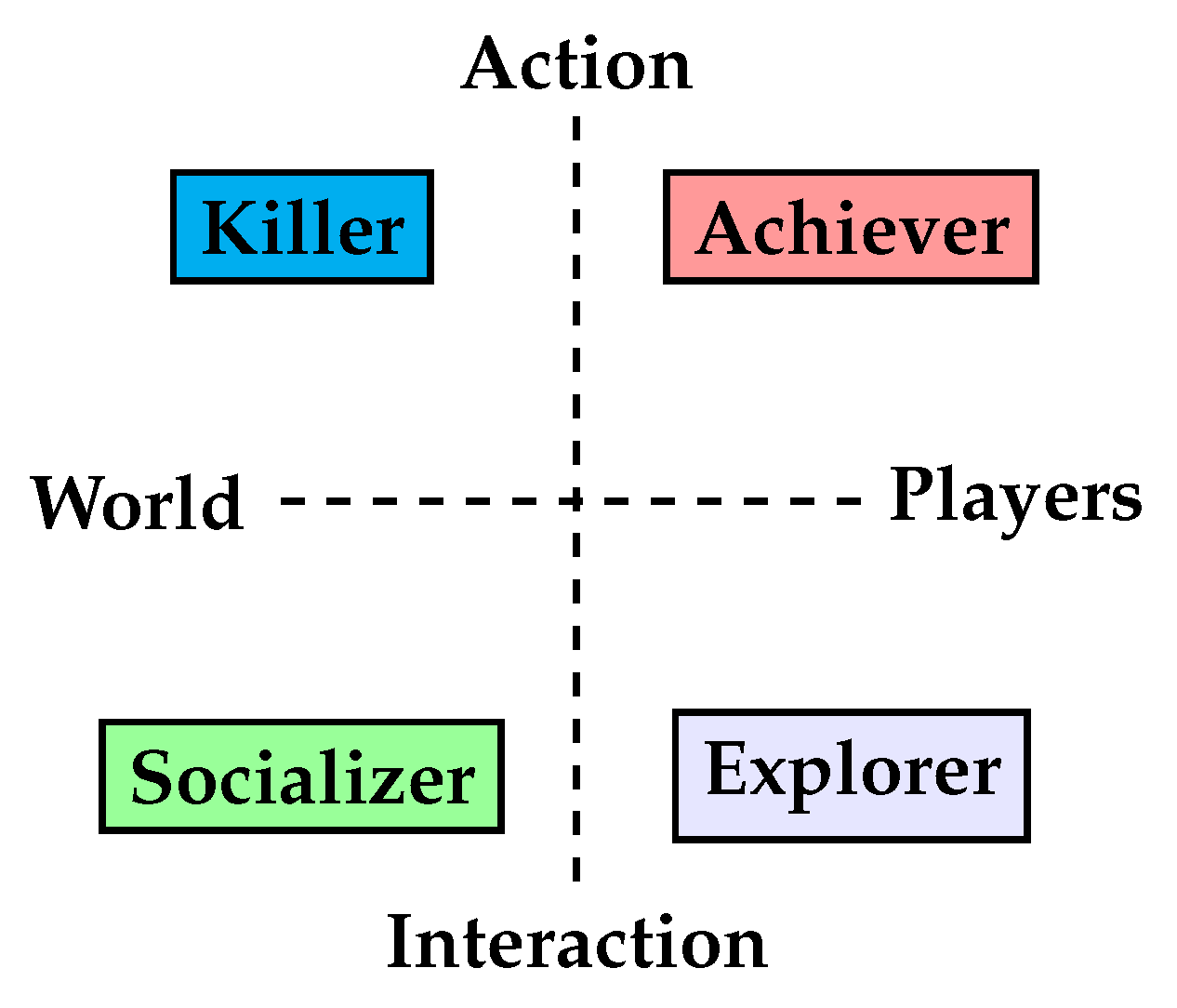
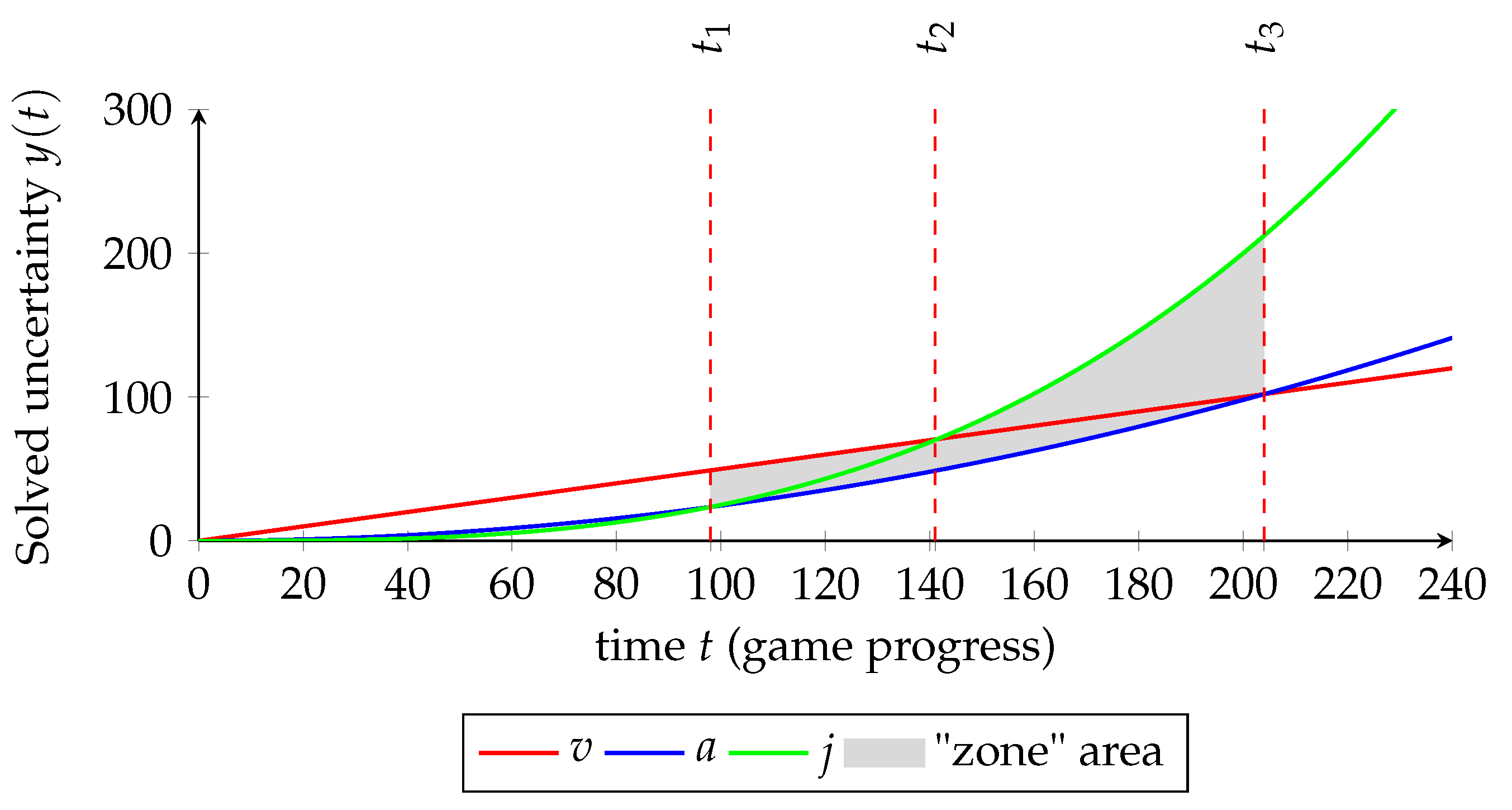
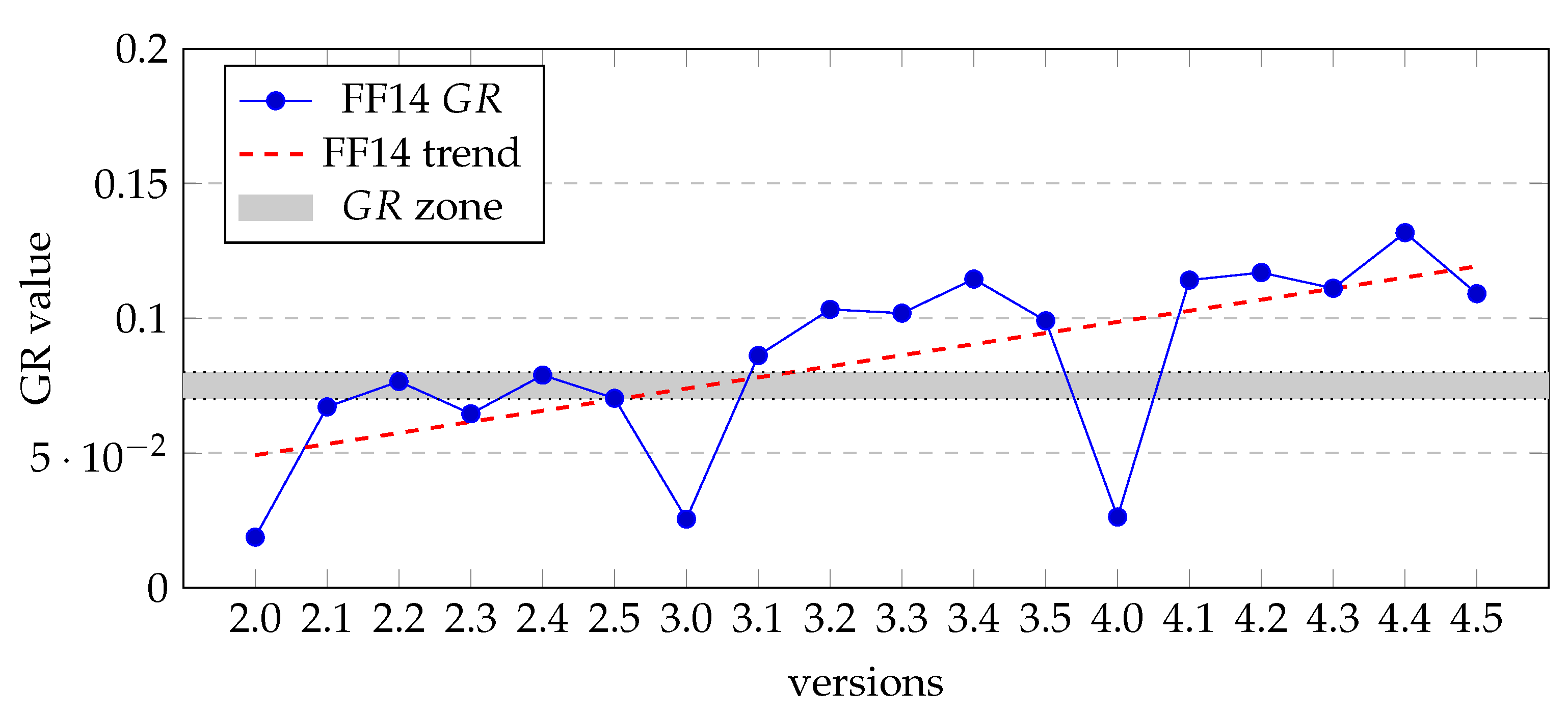
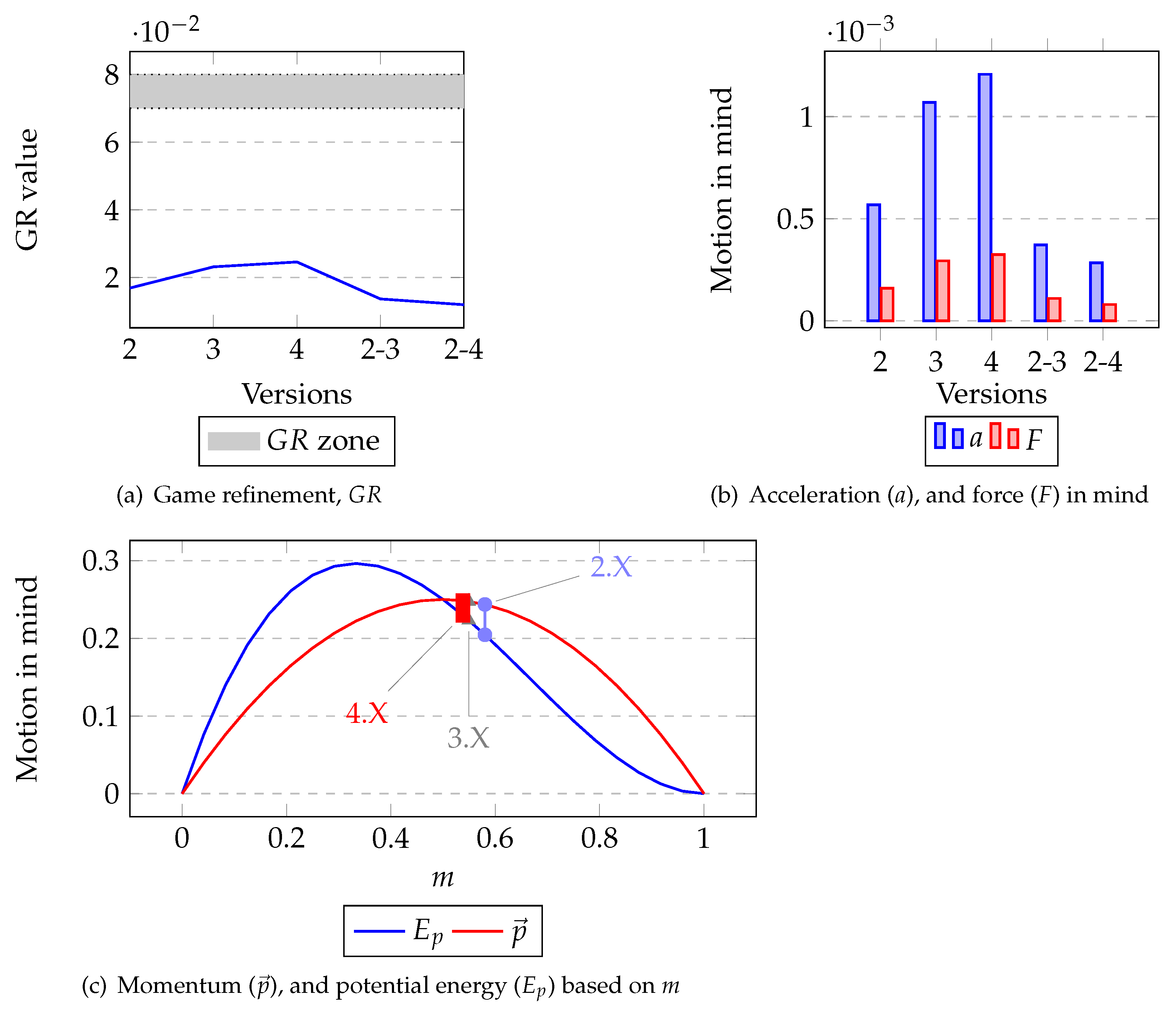

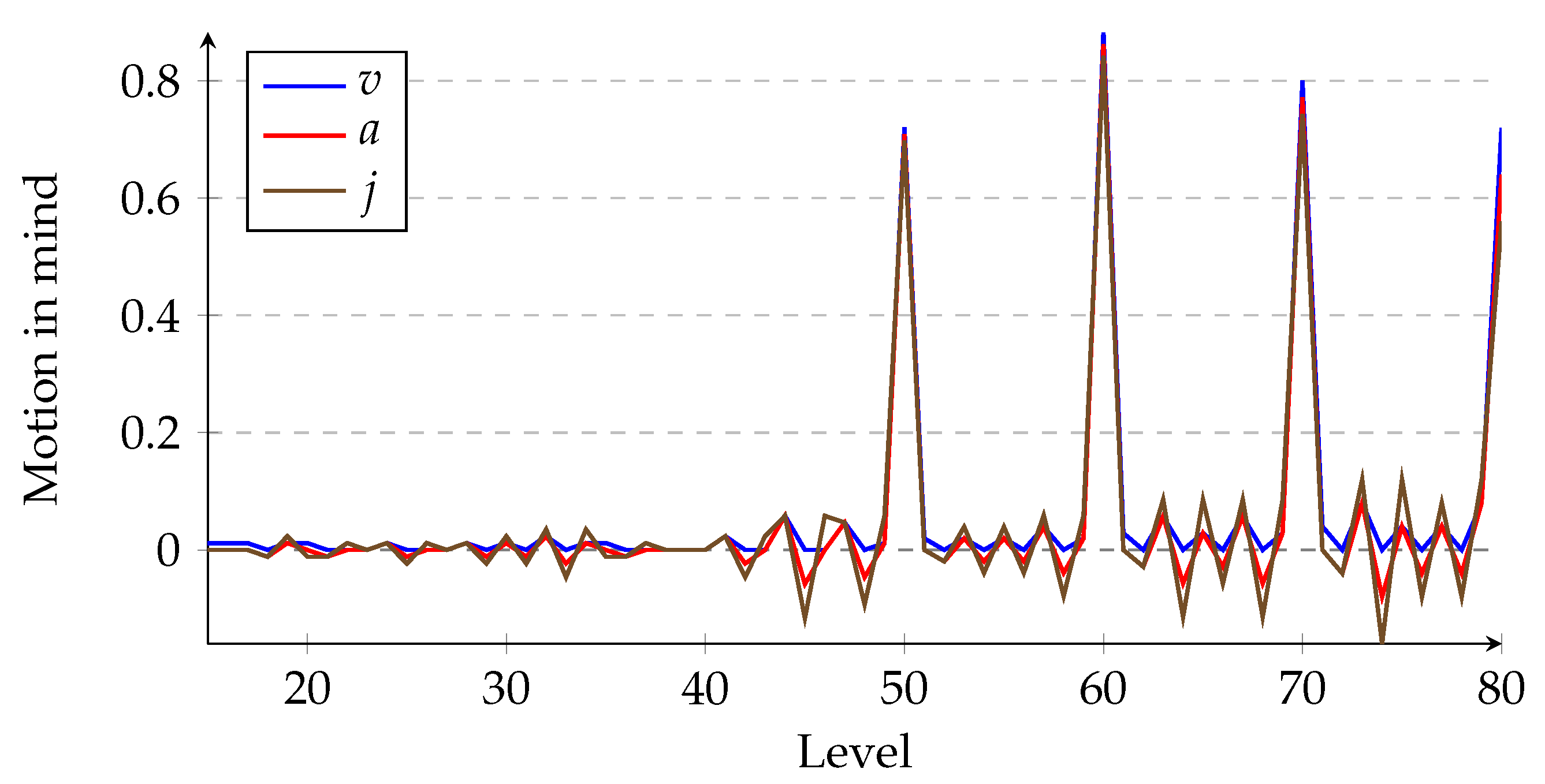
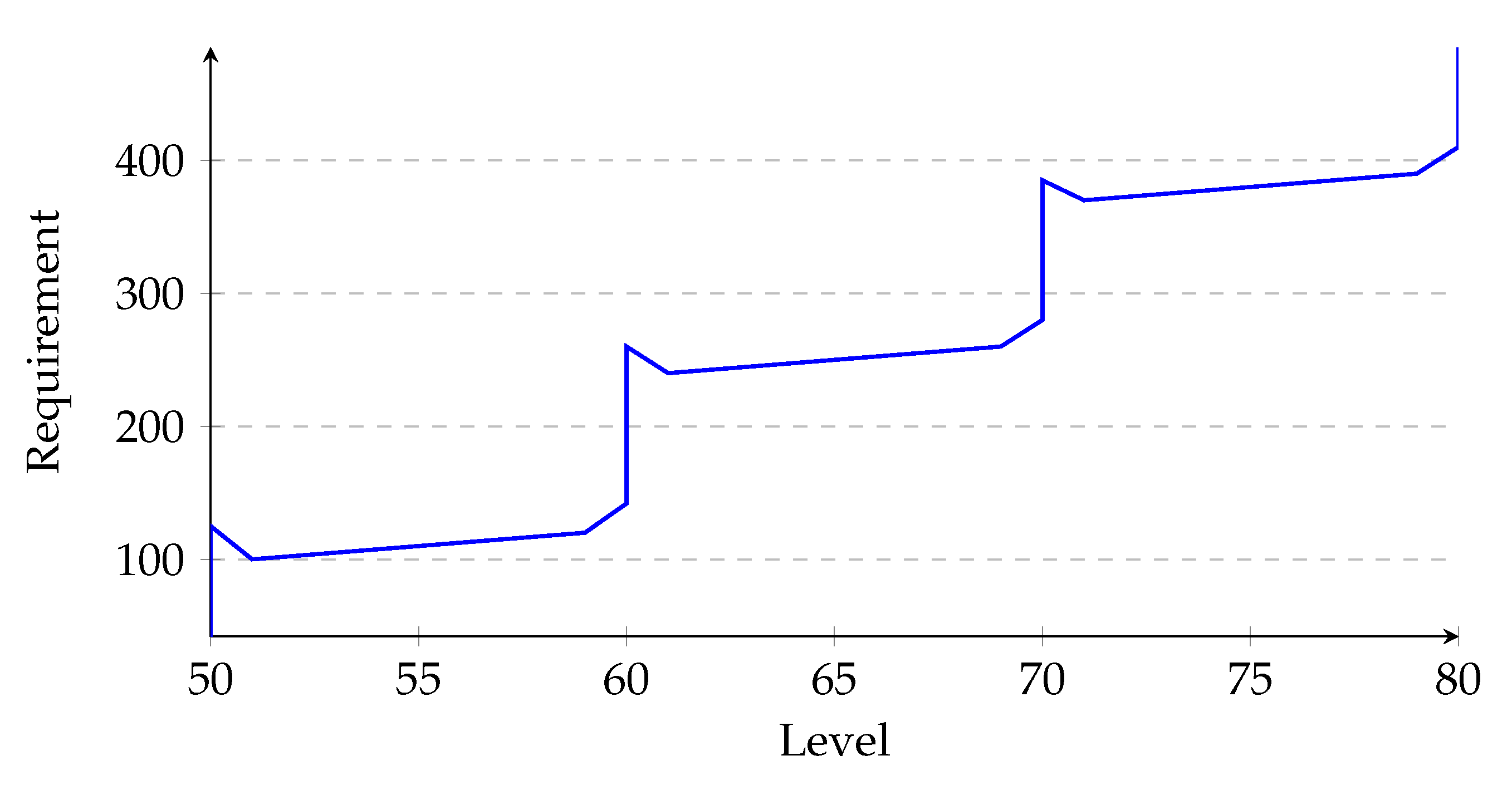
| Games | |||
|---|---|---|---|
| Chess | 35 | 80 | 0.074 |
| Shogi | 80 | 115 | 0.078 |
| Go | 250 | 208 | 0.076 |
| Basketball | 36.38 | 82.01 | 0.073 |
| Soccer | 2.64 | 22.00 | 0.073 |
| Badminton | 46.34 | 79.34 | 0.086 |
| Table tennis | 54.86 | 96.47 | 0.077 |
| DOTA ver 6.8 | 68.60 | 106.20 | 0.078 |
| StarCraft II Teran | 1.64 | 16.00 | 0.081 |
| Mafia (one of the setting) | 6.25 | 46.90 | 0.074 |
| Notation | Game | Physics |
|---|---|---|
| y | Solved uncertainty | Displacement |
| t | Total score/game length | Time |
| v | Winning rate () | Velocity |
| m | Winning hardness | Mass |
| a | Acceleration in mind | Gravitational acceleration, g |
| Momentum of game | Momentum | |
| Potential energy of game | Gravitational potential energy, U |
| Version | Quests | |||||
|---|---|---|---|---|---|---|
| Main | Regular | Special, q | All, Q | |||
| 2 | 290 | 341 | 316 | 947 | 0.3337 | 0.0188 |
| 2.1 | 19 | 31 | 96 | 146 | 0.6575 | 0.0671 |
| 2.2 | 19 | 14 | 93 | 126 | 0.7381 | 0.0765 |
| 2.3 | 19 | 41 | 61 | 121 | 0.5041 | 0.0645 |
| 2.4 | 19 | 21 | 35 | 75 | 0.4667 | 0.0789 |
| 2.5 | 24 | 19 | 19 | 62 | 0.3065 | 0.0703 |
| 3 | 94 | 256 | 188 | 538 | 0.3494 | 0.0255 |
| 3.1 | 8 | 20 | 67 | 95 | 0.7053 | 0.0862 |
| 3.2 | 11 | 10 | 41 | 62 | 0.6613 | 0.1033 |
| 3.3 | 6 | 14 | 48 | 68 | 0.7059 | 0.1019 |
| 3.4 | 10 | 9 | 17 | 36 | 0.4722 | 0.1145 |
| 3.5 | 9 | 16 | 19 | 44 | 0.4318 | 0.0991 |
| 4 | 122 | 213 | 190 | 525 | 0.3619 | 0.0263 |
| 4.1 | 11 | 5 | 38 | 54 | 0.7037 | 0.1142 |
| 4.2 | 8 | 4 | 46 | 58 | 0.7931 | 0.1169 |
| 4.3 | 7 | 7 | 49 | 63 | 0.7778 | 0.1111 |
| 4.4 | 7 | 7 | 10 | 24 | 0.4167 | 0.1318 |
| 4.5 | 7 | 14 | 21 | 42 | 0.5000 | 0.1091 |
| total 2 | 390 | 467 | 620 | 1477 | 0.4198 | 0.0169 |
| total 3 | 138 | 325 | 380 | 843 | 0.4508 | 0.0231 |
| total 4 | 495 | 250 | 354 | 766 | 0.4621 | 0.0246 |
| total (2–3) | 528 | 792 | 1000 | 2320 | 0.4310 | 0.0136 |
| total (2–4) | 690 | 1042 | 1354 | 3086 | 0.4388 | 0.0119 |
Publisher’s Note: MDPI stays neutral with regard to jurisdictional claims in published maps and institutional affiliations. |
© 2021 by the authors. Licensee MDPI, Basel, Switzerland. This article is an open access article distributed under the terms and conditions of the Creative Commons Attribution (CC BY) license (https://creativecommons.org/licenses/by/4.0/).
Share and Cite
Wang, H.; Zhang, Z.; Khalid, M.N.A.; Iida, H.; Li, K. MMORPG Evolution Analysis from Explorer and Achiever Perspectives: A Case Study Using the Final Fantasy Series. Information 2021, 12, 229. https://doi.org/10.3390/info12060229
Wang H, Zhang Z, Khalid MNA, Iida H, Li K. MMORPG Evolution Analysis from Explorer and Achiever Perspectives: A Case Study Using the Final Fantasy Series. Information. 2021; 12(6):229. https://doi.org/10.3390/info12060229
Chicago/Turabian StyleWang, Haolan, Zeliang Zhang, Mohd Nor Akmal Khalid, Hiroyuki Iida, and Keqiu Li. 2021. "MMORPG Evolution Analysis from Explorer and Achiever Perspectives: A Case Study Using the Final Fantasy Series" Information 12, no. 6: 229. https://doi.org/10.3390/info12060229
APA StyleWang, H., Zhang, Z., Khalid, M. N. A., Iida, H., & Li, K. (2021). MMORPG Evolution Analysis from Explorer and Achiever Perspectives: A Case Study Using the Final Fantasy Series. Information, 12(6), 229. https://doi.org/10.3390/info12060229








